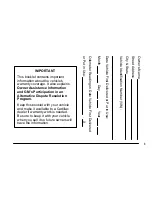
WWW.MANUALS.WS
WWW.MANUALS.WS
114
Even though the anti-lock brake sys-
tem is operating, a driver cannot main-
tain full control on certain slippery road
surfaces, when cornering at high
speeds, or in violent maneuvers.
Avoid high speeds on wet roads. The
anti-lock brake system cannot elimi-
nate the risk of hydroplaning and loss
of tire friction.
Always maintain a safe distance from the
vehicle in front of you. Compared with ve-
hicles not fitted with an anti-lock brake
system, your vehicle may require a longer
stopping distance in the following cases:
Driving on rough, gravel or snow-cov-
ered roads.
Driving with tire chains installed.
Driving on roads where the road sur-
face is pitted or has other differences
in surface height.
CAUTION
!
Do not use tires other than the
manufacturer’s designated tires,
and do not mix tires or wheels of
different sizes. You may prevent the
anti-lock brake system from oper-
ating at full effectiveness.
Type A
Type B
“ABS” warning light
This light comes on when the ignition key
is turned to the “ON” position. After about
3 seconds, the light will go off.
If either of the following conditions occurs,
this indicates a malfunction somewhere in
the parts monitored by the warning light
system. Contact your Toyota dealer as
soon as possible to service the vehicle.
The light does not come on as de-
scribed above, or remains on.
The light comes on while driving.
Even if the anti-lock brake system should
fail, the brake system will still operate con-
ventionally. However, when the “ABS”
warning light is on (and the brake system
warning light is off), anti-lock brake sys-
tem is not assisting brake performance so
that the wheel can lock-up during sudden
braking or braking on slippery road sur-
faces. Have your vehicle checked by your
Toyota dealer as soon as possible.















































